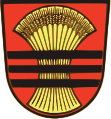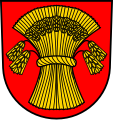Sheaf (heraldry)
As a common figure, the sheaf is a commonly used coat of arms in heraldry .
description
Shown is a sheaf , a bundle of cut and tied stalks of grain , which are mainly shown in gold, i.e. yellow. As in Ahrensfelde , for example, the wheat bundle can be held together with a decorative bow. The sheaf is used in many coats of arms , especially in urban heraldry.
The sheaf is also used as a helmet ornament in the upper coat of arms . Only one stalk or several stalks, usually three, can be used as a symbol in the coat of arms. For sprinkling in the shield but only the ears are used. These are arranged to fill the field. Agricultural implements such as rakes , flails or scythes are also placed behind the sheaf .
Sweden
The figure known as Wasagarbe from the Swedish royal house Wasa has had its place in the coat of arms since 1654 . There she is bound and hung in gold. In Swedish the word 'vase' means sheaf and becomes a talking coat of arms . The figure can also be proven in the Finnish coat of arms of the city of Vaasa , which was founded by the Swedish King Charles IX. is attributed. Even in the Wasa Order , it is depicted on the oval center shield of the award. The Polish kings Sigismund III. Wasa , Władysław IV. Wasa and Johann II. Casimir were Vasa kings and carried the sheaf in the coat of arms.
Coat of arms examples
literature
- Gert Oswald : Lexicon of Heraldry. VEB Bibliographisches Institut, Leipzig 1984.

















